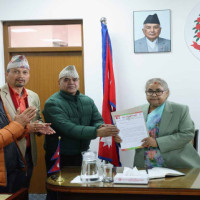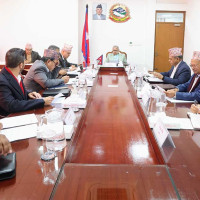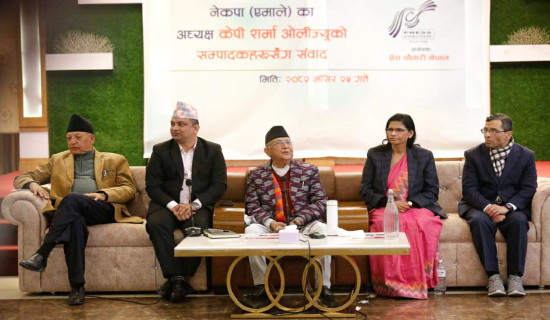- Thursday, 11 December 2025
Experts attribute monsoon-end mayhem to climate change
Warn of frequent extreme weather events in years to come
Kathmandu, Oct. 20: September 28, 2024, turned into a nightmare for Rajan Bohara. The flood that hit early in the morning along the Roshi Khola (river) in the Kavrepalanchowk district that day swept away all his material possessions.
Bohara had constructed a one-storey concrete house after the 2015 earthquake destroyed his traditional home. He lived happily with his three daughters, one son and his wife in that house. He never thought that a strong pillar-house like his could be damaged by an earthquake or anything else, but the torrential rainfall, resulted in an unexpected rise in the Roshi River, and caused devastating flooding that completely damaged Bohara’s house along with 350 others in Roshi Rural Municipality alone.
Another two-storey traditional house, two ropanis of land (one ropani paddy field), two buffaloes and eight goats, were swept away by the flood, Bohara said. “I have nothing except the clothes I am wearing now. I could not save anything. I just carried my son and daughter with me and fled from the house because the house was shaking like during the 2015 earthquake,” he said. His two daughters and wife were in Kathmandu for treatment of one of his daughters at the time, he added.
This was a nightmare for many villagers in the country as they were still recovering from the devastating earthquake that hit the country in 2015. Once again, the flood and landslide on September 27, 28 and 29, 2024, pushed the country back into a phase of reconstruction and relocation.
Among the 50 affected districts, Kavrepalanchowk, Sindhuli and Lalitpur were the hardest hit by the recent floods and landslides. Dinesh Lama, Chairperson of Roshi Rural Municipality, said that Roshi is the most severely impacted rural municipality among the severely affected areas.
In that municipality alone, 12 casualties were reported, over 25 people were injured, and out of 6,000 houses, 350 were completely destroyed while 750 were partially damaged. Similarly, the rural municipality lost a 10-bed hospital, one motorable bridge, three suspension bridges, an industrial village, the Tamang Cultural Museum and 1,000 electric poles, Lama informed.
“We are still sans electricity and internet services. Officials from the Electricity Authority visited our area on Thursday for an assessment. We hope these much-needed services will be restored soon in the rural municipality,” he said.
According to the latest report from the National Disaster Risk Reduction and Management Authority (NDRRMA), the recent floods and landslides in Nepal have led to 236 confirmed casualties, 32 children among them. There are 19 people still missing and 165 individuals have been reported injured.
Record-breaking precipitation, second highest recorded so far
According to the Department of Hydrology and Meteorology (DHM), the country experienced record-breaking precipitation and high temperatures in September 2024, the highest in four decades. A preliminary report from the DHM shows that Nepal received 170.1 per cent more rainfall than the average in September.
Typically, the average rainfall in September is 242.90 mm, but this year, 413.1 mm was recorded in September, making it the highest amount of rainfall in the month since 1981.
Sudarshan Humagain, a meteorologist at DHM, said that according to long-term data available at the DHM, precipitation during the 2024 monsoon season was the second-highest recorded since 1981. The highest precipitation was also recorded in 2020, as per data from DHM’s available rainfall monitoring stations across the country.
The average rainfall during the four months of the monsoon season (June 1 to September 1) is 1,357.1 mm, but this year, the DHM recorded 1,632.8 mm of rainfall from 112 monitoring stations across the country. In comparison, 1,640.6 mm of rainfall was recorded in 2020.
“It is 120.3 per cent of the total average rainfall, which is 20.3 per cent more than usual. Among the 500 rainfall monitoring stations across the country, most are not operational, and the data is being recorded from long-term data available from these working stations,” Humagain said.
Experts’ view
Climate change expert Madhukar Upadhyay said that the extreme rainfall in Roshi had already occurred in 1981, and that event also occurred on the day of Ghatasthapana (the first day of Dashain). The flood swept away Lele and he remembered that the then Prime Minister Surya Bahadur Thapa visited the area by helicopter to observe the damage after the devastating flood and landslide.
Many people died, and the entire lowland area and paddy fields were inundated by the flood. After losing everything, people began moving to Kathmandu, where most started working in brick kilns in Laliptpur. In reference to a report from 2000, only 20 to 30 per cent of the land had been reclaimed by that time. The flood significantly changed the livelihoods and occupation of the people in the area.
According to Upadhyay, floods mixed with sediments can cause more damage. The more sediments mixed with the flood, the greater the damage. The devastating situation in Roshi was due to a sediment-laden flood, as there has been an increase in stone mining. Larger stones are removed, leaving smaller, loose materials that can be easily swept away by heavy rainfall and mixed up with river floods causing more damage.
The rainfall in Fulchoki on September 27 midnight was of high intensity even though there is no recorded data so far with DHM.
The already rain-soaked land suffered shallow landslides in various areas, including Nakhu, Nallu and Roshi including Panauti Municipality. The river changed its course, which is a very interesting phenomenon, he said. The BP Highway was swept away, losing its original path. All these phenomena indicate the high-intensity rainfall in Fulchoki, he added.
“In the past few years, we have seen changes in the monsoon pattern. The monsoon is shifting northward, and all of these changes are attributed to the impact of climate change,” he said.
“If we do not reduce greenhouse gas emissions, the impacts of climate change will worsen in the years to come. The Indian Ocean (Hinda Mahasagar) is heating up, Antarctica is warming and global temperatures are rising. There is already ample evidence of these changes because we have been seeing the impact in Nepal for the past few years. The winter in 2022 and 2023 remained dry and there is a change of drought in this winter too. Even though we are getting light rainfall, that is not enough for snowfall,” Upadhyay said.
What caused extreme precipitation this year?
The end of this year’s monsoon season witnessed heavier-than-usual rainfall across the country.
Various factors, including the rise in sea surface temperatures, air pressure systems, El Niño-Southern Oscillation (impact precipitation, temperature
patterns, and the intensity of monsoons) and atmospheric dynamics, caused the monsoon system to be stronger than usual, said Bibhuti Pokharel, Chief of the Climate Section under the DHM.
“Although 2024 was not impacted by both La Niña and El Niño, fragments of the oceanic cycles and atmospheric conditions could still play a role in affecting rainfall intensity,” she said.
“After observing the various models, we had already predicted above-normal rainfall this year and disseminated the information through various means, but the extreme precipitation towards the end of the monsoon season is not something usual,” she added.
According to her, the extreme precipitation at the end of the monsoon and the increase in intensity are attributed to the impact of climate change. “Extreme events like this year are not going to stop here, and there might be more frequent climate extremes in the coming years. So we need to be prepared for more events like this,” Pokharel said.
This year, the monsoon arrived three days earlier than usual, beginning on June 10 and it retreated from October 12.
How did you feel after reading this news?
















